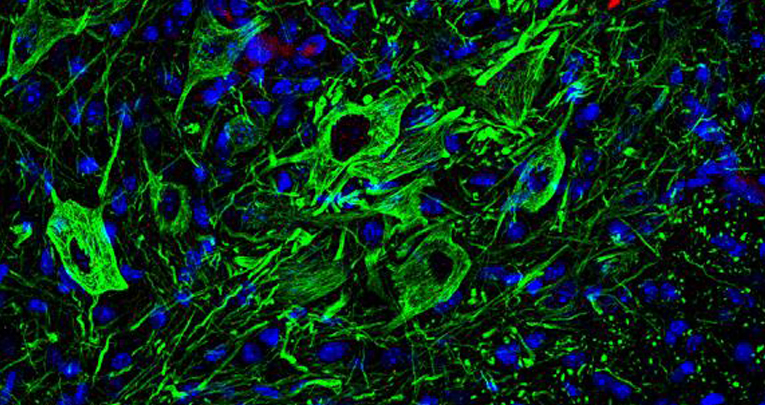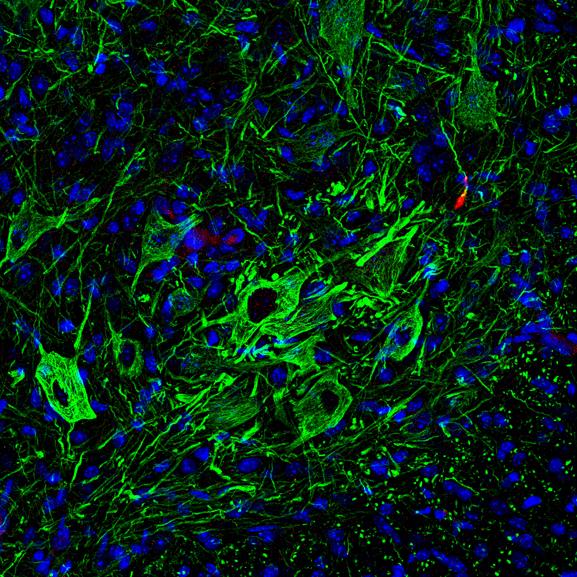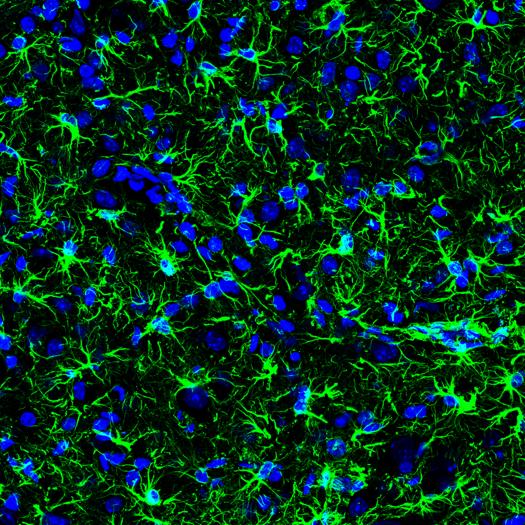
Cellular and Molecular Life Sciences , 22 July 2022
Moxifloxacin rescues SMA phenotypes in patient-derived cells and animal model
Camille Januel 1 , Giovanna Menduti 2 , Kamel Mamchaoui 3 , Cecile Martinat 1 , Ruben Artero 4,5 , Piotr Konieczny 4,5 , Marina Boido 2
NICO Research Group Brain Development and Disease
Abstract
Spinal muscular atrophy (SMA) is a genetic disease resulting in the loss of α-motoneurons followed by muscle atrophy. It is caused by knock-out mutations in the survival of motor neuron 1 ( SMN1 ) gene, which has an unaffected, but due to preferential exon 7 skipping, only partially functional human-specific SMN2 copy. We previously described a Drosophila -based screening of FDA-approved drugs that led us to discover moxifloxacin.
A representative confocal image showing the ventral horn of the lumbar spinal cord, where the SMI32-positive motor neurons (MNs; green) are located. Our results demonstrated a significantly higher MN density in moxifloxacin-treated mice compared to control mice, suggesting that the treatment is effective in delaying the SMA-associated cell death of MNs.
We showed its positive effect on the SMN2 exon 7 splicing in SMA patient-derived skin cells and its ability to increase the SMN protein level. Here, we focus on moxifloxacin's therapeutic potential in additional SMA cellular and animal models. We demonstrate that moxifloxacin rescues the SMA-related molecular and phenotypical defects in muscle cells and motoneurons by improving the SMN2 splicing. The consequent increase of SMN levels was higher than in case of risdiplam, a potent exon 7 splicing modifier, and exceeded the threshold necessary for a survival improvement.
We also demonstrate that daily subcutaneous injections of moxifloxacin in a severe SMA murine model reduces its characteristic neuroinflammation and increases the SMN levels in various tissues, leading to improved motor skills and extended lifespan. We show that moxifloxacin, originally used as an antibiotic, can be potentially repositioned for the SMA treatment.
Open Access | read full article
The picture shows the remarkable reactive astrogliosis (GFAP-positive signal; green) present in the ventral horns of the spinal cord of SMA mice. The treatment administration significantly reduced the neuroinflammation, possibly further contributing to the moxifloxacin-supported MN preservation.
1 INSERM/UEVE, UMR 861, Université Paris Saclay, I-STEM, AFM-Telethon, Rue Henri Desbruères, 91100 Corbeil-Essonnes, France
2 Department of Neuroscience “Rita Levi Montalcini”, Neuroscience Institute Cavalieri Ottolenghi, University of Turin, Regione Gonzole 10, Orbassano, 10043 Turin, TO, Italy
3 Sorbonne Université, Inserm, Institut de Myologie, Centre de Recherche en Myologie, 75013 Paris, France
4 University Institute of Biotechnology and Biomedicine (BIOTECMED), Universitat de València, Street Dr. Moliner, 50, 46100 Burjasot, Valencia, Spain
5 Translational Genomics Group, Incliva Biomedical Research Institute,









